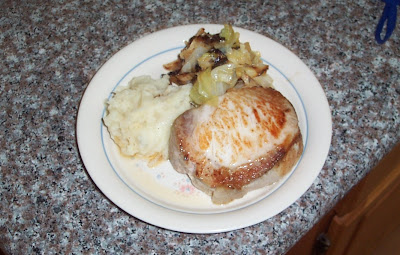The pork chop, well executed, is a great meal, especially with some roasted vegetables and a good starch. However, pulling off a great pork chop isn't the easiest thing if you just go in with a pork chop, seasoning and a pan. Without a well honed technique, without proper preparation such a pork chop may end up overcooked, dry and less palatable than you'd like. Thankfully, there's one simple technique that makes a pork chop (and several other meats) have a much lower margin of error: brining.
By submerging meat in a liquid of salt and sugar, a cook is able to lock in more of the juices. As explained in
Charcuterie: The Craft of Salting, Smoking, and Curing "salt changes the shape of the protein in the meat or bird so that it can actually hold more juice than unbrined meat."This same book provides the recipe I'm using for pork chops. This brine is for 4 thick pork chops.
We've got the mise en place:
pepper (1 tbsp)
kosher salt (1/2 cup)
brown sugar (3/4 cup),
sage (4 tbps - it's supposed to be fresh..)
and garlic, lightly smashed
NOTE: There's a good amount of sitting around and waiting time in this recipe, so this is definitely not an "I feel like this tonight, I'll start at 3pm" sort of thing. I'll admit it is a bit of a production.
All of the ingredients are combined into 2 quarts of water and brought to a simmer, stirring often.
Once the salt and sugar have been dissolved, let the solution cool, then put in the refrigerator to chill.
Once chilled, throw in your pork chops. Four thick chops go into the chilled liquid, then back into the refrigerator for 2 hours.
Once chilled, throw in your pork chops. Four thick chops go into the chilled liquid, then back into the refrigerator for 2 hours.
I put on some plastic wrap to prevent the chops from being exposed to air. After two hours, remove the chops, rinse them and put them in the refrigerator uncovered for at least an hour and up to a day.
I've decided to accompany the chops with mashed rutabaga and turnips.
Treat like mashed potatoes, bring to a boil in salted water, and check at 20 minutes and every ten or five minutes after with a fork. If a piece is pierced easily, then you're probably ready to mash it.
During the early part I added some powdered chicken buollion to give it that cooked in chicken broth feeling.
I put the nips into the vitamix. A masher will do as well.
The chops can be prepared either on a grill or by pan roasting. I opted for the latter.
I forgot to take the searing picture, but I seared the chops on each side, then slide them into a preheaded 350 degree oven.
I forgot to take the searing picture, but I seared the chops on each side, then slide them into a preheaded 350 degree oven.
New toy! Check it out! A probe thermometer let me pull them out at 140 degrees internal temperature. I may have let it get a bit over.
A probe thermometer let me pull them out at 140 degrees internal temperature. I may have let it get a bit over.
And there they are!
It may be hard to tell, but what I'm trying to show is how the chop is both perfectly cooked through and moist at the same time.
Happy cooking everyone!

















































